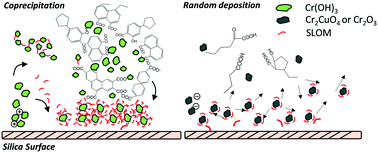Colloidal stabilities and deposition behaviors of chromium (hydr)oxides in the presence of dissolved organic matters: role of coprecipitation and adsorption†
Abstract
Cr (hydr)oxide colloids are regarded as insoluble products of toxic Cr(VI) during the long-term remediation process. However, dissolved organic matters (DOMs) may significantly alter the fate and mobility of Cr (hydr)oxide colloids and pose the risk of Cr(VI) secondary release. In this study, we evaluated the impacts of sediment leaching organic matters (SLOMs) on the stabilities and deposition behaviors of Cr (hydr)oxide colloids by time-resolved dynamic light scattering (DLS) and quartz crystal microbalance with dissipation (QCM-D) techniques. The results indicated that in the presence of SLOMs, the colloidal size of Cr hydroxides (i.e., Cr(OH)3) increased over time due to the formation of coprecipitates with aromatic compounds containing oxygenated groups. In contrast, the SLOMs were largely adsorbed onto Cr oxide (i.e., Cr2O3 and Cr2CuO4) surfaces via non-specific interactions and disaggregated these colloids due to charge accumulation and steric effects. As a result, Cr(OH)3 sequesters a higher content of organic molecules than Cr2O3 and Cr2CuO4. Such differences in the association mechanism of Cr (hydr)oxides with SLOMs resulted in different deposition behaviors. The deposition of Cr(OH)3 on the silica surface in the presence of SLOMs depended on heterogeneous coprecipitation, which led to a higher deposition rate and mass under a higher SLOM loading. Heterogeneous coprecipitation of Cr(OH)3 and SLOMs on the silica surface led to initially irreversible deposition and compact layer nature. However, the deposition of Cr oxides in the presence of SLOMs was reversible and only relevant to their colloidal stabilities and surface charges that relied on surface adsorption of organic molecules. This study highlighted the importance of crystal forms for evaluating the fate and mobility of Cr (hydr)oxides in the presence of DOMs and potential environmental risks of long-term Cr-contamination remediation.

- This article is part of the themed collection: Environmental fate of nanomaterials


 Please wait while we load your content...
Please wait while we load your content...